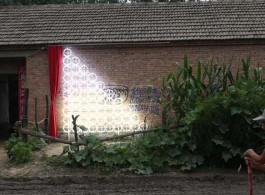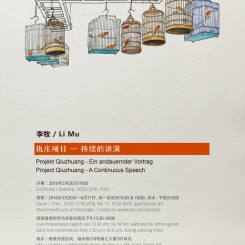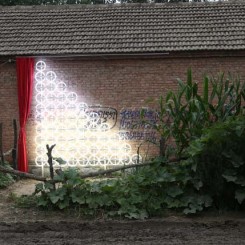The “Qiuzhuang Project” is a long-term art project launched by artist Li Mu in his home village of Qiuzhuang. In search of connection with his hometown, LI Mu began reproducing important collections from the Van Abbemuseum in the Netherlands. The artist has set up a library project in the village as public space for displaying artworks and organizing activities to engagelocal villagers. Working together with villagers, LI Mu set about reproducing the artworks of Dan Flavin, Andy Warhol, Daniel Buren, John Körmeling, Ulay, Marina Ambramovic amongst others. The replicas are distributed and placed in the houses and streets of the village. Exhibition of the replicas in Qiuzhuang started in 2013, and more will come as the project continues. The project has attracted curators and media to visit from the United States, Canada, Australia, Italy, etc. It has also caused misreading and misrepresentation in the western world. In the process, LI Mu’s parents and fellow villagers have gone through psychological and awareness changes. As an artist, what LI Mu has achieved with the project has also turned Qiuzhuang into a village of questions. Goethe Open Space intends to display the “Qiuzhuang Project” through a public education approach. When the audience enters the space, a narrator will start talking about concept and developments of the “Qiuzhuang Project”. The narrator shall add personal understanding to each narration. The exhibition will be established entirely on narration, creating an “Art Institute in Village” framework that’s above the physical environment.
Moving Institutions
Since 2010, a growing number of artists have been imitating the functionality and operation mode of today’s institutions by means of media-based tools, to create participatory artworks and to construct definition, exhibition, research, education and other functions dedicated to the continuation of artworks’ life, like contemporary art institutions. Those works are usually low-cost, front-line guided, structurally simple and flexible, and exist in forms of “view”, “plan” or “project”; in short, they are “Moving Institutions”.
In fact, the relationship between contemporary artworks and the audience has long left its traditional form. They are no longer the spiritual massage inside the white box completely isolated from the audience. This already provides the artworks an opportunity to construct an intermediate link between the audience and the society – an uninvited Utopia. Unlike the “Boîte-en-valise” by Marcel Duchamp or “The Museum of Drawers” by Herbert Distel, the way this “Utopia” adds legitimacy to itself is to use the conceptual framework of the white cube, but giving it variable or invisible exterior.
There is no dialogue between individuals and the society today. The platform between individuals and the society is the actual governor of the social discourse. The “Moving Institution” appears in the governing form well-liked by the masses of people, in an intermediary position where the audience are used to in order to understand the world. It skips the long process of struggle and dressed itself as the governor of discourse directly.
Another important feature is that those works emerge and develop in an environment where commercial capital devours everything. The sponsoring of contemporary art generally no longer appears in individual form, while personal projects are more difficult to operate in the commercial system. Obviously, in the business context, institution-to-institution dialogues are more reasonable. For the purposes of communication, artists have taken the initiative to shape an economic model or equivalent dialogue mechanism in line with the business context. Active transformation has become a small cultural body (Utopia), seeking its own legitimacy.
One tendency is that artists are inarticulate instead of constructive enough in the creation of this “institution”, thus become the product of compromise. It reaches certain balance without any premeditation and becomes questionnaire. The lively representation (entertainment) is attached with the illusion of certain cultural needs (art movement), and the audience has not really received anything.
Another tendency is that, as an art form, “institution” falls easily into the state of “already aged before it starts”. From the perspective of “institution”, low-cost, downsizing, individualization, Internetization and quick interactive response turn out to be the most promising model for future art institutions. Philippe Parreno and Pierre Huyghe bought a cartoon character Ann Lee from the Kworks, and Ann Lee bought its two-dimensional (image) in the nature of human (three-dimensional). This can be an example.
Therefore, from the external perspective, these “institutions” are flattering, rolling, growing, deforming, even delaying and atrophying……The Goethe Open Space presents the creation of four artists taking place in four phases: “Exhibitionist” (Ye Funa), “The Gallery” (Wang Xin), “Qiuzhuang Project – Andy Warhol in Qiu Zhuang” (Li Mu), “Under the Stone Bridge Project” (Huang Songhao). These “Moving Institutions” will prove with their latest actions as an observation point: how business environment consumes, grinds and guides the production decisions of artists, and how they response to it and shape the “Moving Institution”.




